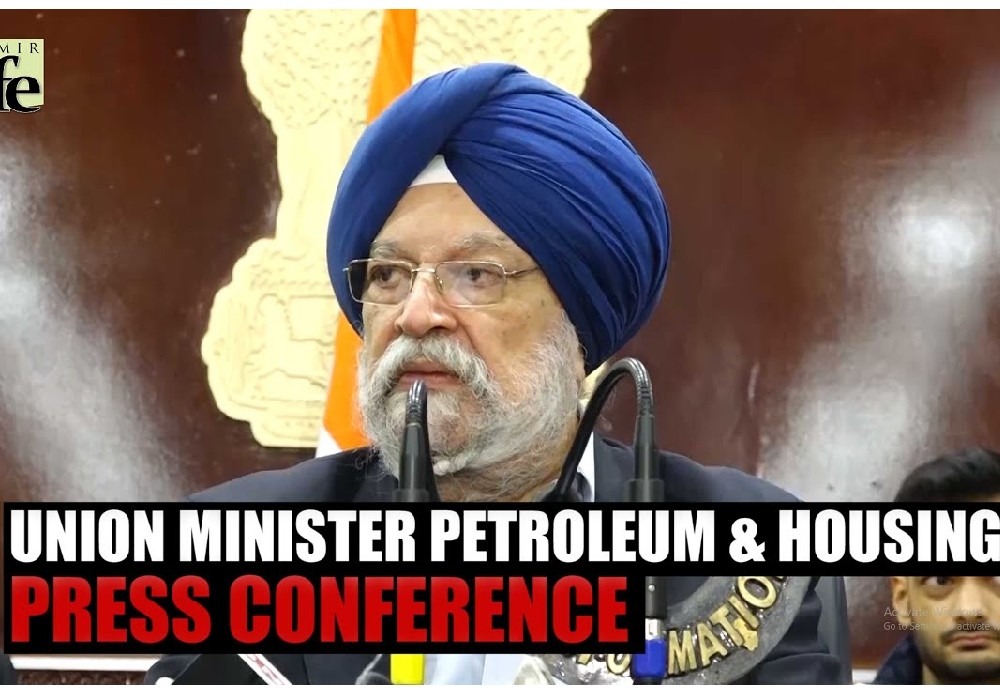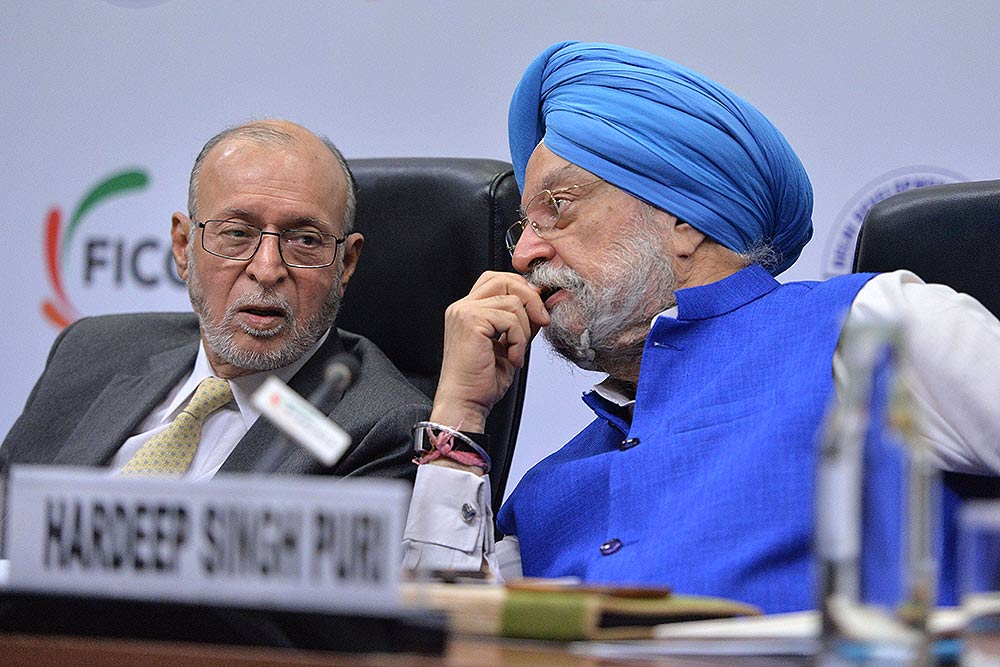5TH Anniversary of Urban Missions
Jun 25,2020
Shri Hardeep Singh Puri, Minister of State for Housing and Urban Affairs(I/C)has stated that“India has undertaken one of the most comprehensive planned urbanization programmes in the history of the worl. The vision of our Hon’ble Prime Minister of a New India is closely intertwined with our flagship programme achievements.On 12 May 2020, Hon’ble Prime Minister launched the Atma Nirbhar Bharat Abhiyan which focuses on providing relief as well as help to farmers, cottage industries, home industry, small-scale industries, MSMEs - which are the means of livelihood for crores of people who were adversely impacted by the lockdown measures”.He was addressing a webinar to mark the 5thAnniversary ofPradhan Mantri Awas Yojana(Urban) (PMAY-U), Smart Cities Mission (SCM) and Atal Mission for Rejuvenation and Urban Transformation (AMRUT) in the presence of Shri Durga Shanker Mishra, Secretary, MoHUA. The online event was organized by Ministry of Housing and Urban Affairs to celebrate the achievements and boost implementation of the urban missions. The event was attended by Joint Secretaries and Mission Directors of AMRUT, SCM, PMAY-U, Principal Secretaries (Urban Development) of State Government and UTs, State Mission Directors, Municipal Commissioners/CEOs of Smart Cities, representatives of partner agencies / Bilateral / Multilateral Institutions and other key stakeholders.
The key announcements and launch events at the Webinar included :
- E-Book of the Ministry of Housing & Urban Affairs showing the progress and achievements of all Missions of the Ministry.
- National Institute of Urban Affairs (NIUA) Website is revamped to strengthen it as a knowledge bank for emerging topics on urban development, while continuing to be a source of everyday resources for urban development functionaries and practitioners.
- National Urban Learning Platformis a platform for digitally consolidating key skills and knowledge required for capacity building, which is a constant requirement for effective governance and nurturing leadership at city, state and national level.
- NIUA Climate Center for Cities (C3) has been setup to consolidate and institutionalize and mainstream the learnings from experiences in our cities on climate change.
- NIUA Center for Digital Governance (CDG) isan initiative to take forward the digital efforts of MoHUA and become the anchor to accelerate digital transformation of urban governance across all States and Cities.
- Video Launch: Outcomes of PMAY- U: showing the progress and achievements of PMAY-U, along with testimonials of beneficiaries of the Mission.
- E-Book Launch: PMAY(U) - Khushiyon ka Aashiyana: showing the progress and achievements of PMAY-U, along with testimonials of beneficiaries of the Mission
- Video Launch: Outcomes of AMRUT: showing the progress and achievements of AMRUT, along with testimonials of beneficiaries of the Mission.
- Book Launch: COVID Diaries: is a collection of personal reflections / opinion articles from members of Smart Cities Mission team as they navigate changes in their daily lives and work routines during COVID-19 pandemic.
- Book Launch: The Smart Responses to COVID-19: How Indian Cities are fighting through Action and Innovation (Volume-1) compendium is an attempt to showcase how urban India has responded to the challenges posed by the pandemic.
- City Finance Portal: First time effort of getting financial Statements of all cities on single platform to enable sharing and learning of best practices and to help ULBs in accessing market funds.
- Cycles4Change Challenge: India Cycles4change Challenge is an initiative of Smart Cities Missionto inspire and support Indian cities to quickly implement cycling-friendly initiatives in response to COVID-19. The idea is to begin by creating low-cost interventions like pop-up cycle lanes and non-motorized zones, launch programs such as community-led cycle rental schemes and promote cycling usage through public events.
Progress, Achievements and Outcomes of AMRUT, SCM and PMAY-(U)
Atal Mission for Rejuvenation and Urban Transformation (AMRUT)
Atal Mission for Rejuvenation and Urban Transformation (AMRUT),launched by Hon’ble Prime Minister on 25 June 2015, has completed 5 successful years. The Mission aims at ensuring universal coverage of drinking water supply and substantial improvement in coverage and treatment capacities of sewerage and septage, along with storm water drainage, non-motorized urban transport and green spaces & parks. The Mission spans across 500 cities, covering more than 60% of urban population.
- State Annual Action Plans (SAAPs) worth ₹ 77,640 crore approved and projects worth ₹ 75,829 crore grounded so far. Projectsworth ₹ 10,654 crores completed and ₹ 65,175 crore in advanced stages of implementation.
- ₹ 39,011 crore allocated for drinking water supply projects, and ₹ 32,546 crore for sewerage and septage projects.
- Concerted effort made at national level to provide water to about 1.39 crore households and sewerage/septage services to about 1.45 crore households.
- 79 lakh household water tap connections and 45 lakh sewer connections have been provided, including in slums and low-income habitations.
- The Mission helped cities to undertake a set of 11 reforms comprising 54 milestones aimed at strengthening capacities of city level institutions for effective governance and citizen service delivery.
- In order to promote energy efficiency across the Indian cities, 76 lakh streetlights replaced with energy efficient LED streetlights.
- Online Building Permission System (OBPS), implemented as a digital transformation-based reform is aimed at reducing the overall time taken for approvals of building plans, while ensuring aseamless process. Owing to the implementation of the reform across 2,057 cities, including 444 AMRUT cities, India’s ranking rose to 27th position in the World Bank Doing Business Report (DBR) 2020, in the Ease of Doing Business in Construction Permits, moving up from 181 rank in DBR 2018, showing remarkable improvement since the implementation of the reform.
- Credit rating exercise undertaken in 469 of the 500 Mission cities, out of which 163 cities have been found as Investible Grade. During 2019-20, 8 cities raised ₹ 3,390 crore through municipal bonds to undertake capital investment projects aimed at improving service delivery and city level infrastructure. Ministry awarded ₹ 1,839 crores as incentive to 26 States/UTs for reform implementation, including ₹ 181 crores for issuance of municipal bonds. So far 53,000 functionaries have been trained under the Mission, against a target of 45,000 functionaries.
Smart Cities Mission (SCM)
Smart Cities Mission (SCM) was launched on 25thJune 2015 with the objective of promoting cities that provide core infrastructure and give a decent quality of life to its citizens, a clean and sustainable environment and application of ‘Smart’ solutions. As on date, the value of tendered smart city projects is over ₹1,66,000crores, the value of work orders issued is about₹ 1,25,000 crores and the value of all completed projects is more than ₹ 27,000 crores.
- An additional 1000 projects amounting to ₹32,500 crore have been tendered and 1000 projects amounting to ₹ 36,000 crore grounded during last one year.
- 180% growth in the completed project in the last one year, amounting to ₹ 12,100 Crore.
- The Integrated Command and Control Centres (ICCC) developed under the Smart Cities Mission have helped cities in their fight against COVID. The 47 operational ICCCs became war-rooms and have played an effective role in COVID response.
- 33 ICCCs are at various stages of implementation. Smart Roads / Complete Streets, Smart Solar, Smart Water, PPPs and Vibrant Public Spaces projects are heading towards progressive paths in the Mission.
- The Urban Learning Internship Program (TULIP)’ is designed for all ULBs and Smart City SPVs to engage fresh graduates as interns. More than 25,000 students have registered on the platform so far and more than 1000 internship positions have been posted by the cities. This will increase the capacity of our cities and positively engage our youth by making them market ready.
- ClimateSmart Cities and DataSmart Cities are two important programs under Smart Cities Mission. They are key enablers, driving the future course of action through data driven performance management, urban innovation and institutional capacity building.
- 114 India cities participated in the Ease of Living and Municipal Performance Index(EoL and MPI. Many cities have participated in the Citizen Perception Survey exercise undertaken by the Ministry under EoL. More than 3 million people have filled these surveys and given constructive feedback on their cities.
- Top 20 cities have been paired as ‘Sister cities’ with 20 cities who were behind in ranking. This has generated great enthusiasm amongst cities and stakeholders, wherein cities are helping each other to learn and perform.
- Smart Cities Mission is supporting interested cities in raising finance through Municipal Bonds. Recently, six cities were selected for technical assistance from US Treasury department to raise municipal bonds.
- Joint efforts of Smart Cities Mission with AGNI and Invest India is fostering growth of a start-up culture in Smart Cities. The Smart Technology Showcase between the start-ups and our City administrators was undertaken by the Mission.
Pradhan Mantri Awas Yojana – Urban (PMAY-U)
Pradhan Mantri Awas Yojana – Urban (PMAY-U) completed five years on 25 June 2020. The scheme was launched in 2015 with the objective of providing pucca house to all eligible beneficiaries of Urban India by 2022 with the vision of ‘Housing for All’. The Mission’s journey of five years has seen several milestones. The Ministry of Housing and Urban Affairs (MoHUA) has received a validated demand of about 1.12 Cr houses under PMAY (U). Approvals for 1.05 Cr houses have already been sanctioned, of which 65 lakhs are grounded and 35 lakhs have been built and delivered to beneficiaries across the country.
- The number of houses sanctioned in last five years under the Mission is almost eight times more than those sanctioned under earlier urban housing schemes during the span of 10 years.
- To ensure regular flow of funds for implementation of PMAY(U), National Urban Housing Fund has been created to mobilize ₹ 60,000 Cr throughExtra Budgetary Resources over and above the budgetary allocation for the Mission.
- Through the Credit Link Subsidy Scheme (CLSS),for the first time, the Middle Income Group (MIG) is being provided benefits for their housing needs. More than 10 lakh beneficiaries belonging to Economically Weaker Sections (EWS), Lower Income Group (LIG) and MIG have so far been brought under the fold of CLSS.
- Government has identified many alternative and innovative technologies through a Global Housing Technology Challenge- India. 6 Light House Projects are being implementedin six states across the country which will act as live laboratories demonstrating innovative, proven construction technologies for speedier and cost-effective construction of houses which are sustainable green, eco-friendly and disaster resilient.
- In 2019 only, MoHUA launched Angikaar- a campaign for change management in more than 4000 cities. The campaign addressed and enabled beneficiaries to adapt to life transformation that comes with shifting to a newly constructed house. The campaign also converged with other government schemes like Ayushman Bharat and Ujjawala so that beneficiaries could avail the benefits of these schemes. Around 20 lakh households were covered in the campaign.
- In line with ‘AtmaNirbhar Bharat’, an Affordable Rental Housing Complexes (ARHCs) scheme for providing ease of living to Urban Migrants/ Poor has been announced by the Hon’ble Finance Minister on 14 May, 2020. The beneficiaries for ARHCs scheme would be the urban migrants/poor from EWS/LIG categories including labours, urban poor (street vendor, rickshaw puller, other service providers etc.), industrial workers, educational/ health institutions, hospitality sector, long term tourists, students or any other category as deemed fit by the States/UTs.
- Construction activity under the scheme has had a huge impact on the other sectors of the economy with a multiplier effect in employment generation. Employment for approximately 1.65 Cr citizens has been generated through forward and backward linkages. Around 370 lakh metric tonne cement and 84 Lakh metric tonne steel has been consumed due to investment being made in the houses grounded.
****
RJ/NG



(3).jpg)